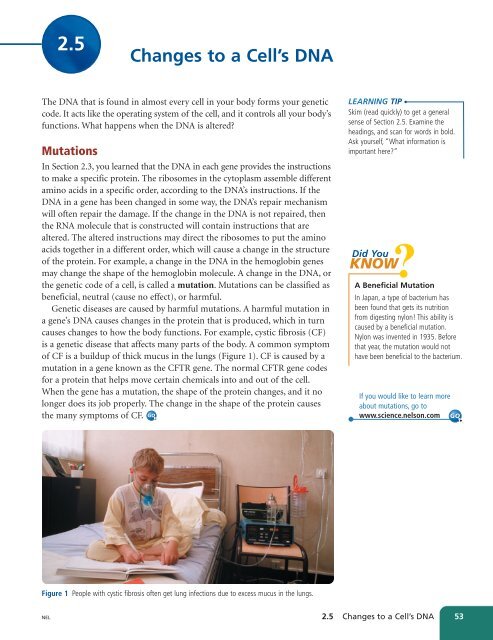Unit A Reproduction
Unit A Reproduction
Unit A Reproduction
Create successful ePaper yourself
Turn your PDF publications into a flip-book with our unique Google optimized e-Paper software.
2.5<br />
Changes to a Cell’s DNA<br />
The DNA that is found in almost every cell in your body forms your genetic<br />
code. It acts like the operating system of the cell, and it controls all your body’s<br />
functions. What happens when the DNA is altered?<br />
Mutations<br />
In Section 2.3, you learned that the DNA in each gene provides the instructions<br />
to make a specific protein. The ribosomes in the cytoplasm assemble different<br />
amino acids in a specific order, according to the DNA’s instructions. If the<br />
DNA in a gene has been changed in some way, the DNA’s repair mechanism<br />
will often repair the damage. If the change in the DNA is not repaired, then<br />
the RNA molecule that is constructed will contain instructions that are<br />
altered. The altered instructions may direct the ribosomes to put the amino<br />
acids together in a different order, which will cause a change in the structure<br />
of the protein. For example, a change in the DNA in the hemoglobin genes<br />
may change the shape of the hemoglobin molecule. A change in the DNA, or<br />
the genetic code of a cell, is called a mutation. Mutations can be classified as<br />
beneficial, neutral (cause no effect), or harmful.<br />
Genetic diseases are caused by harmful mutations. A harmful mutation in<br />
a gene’s DNA causes changes in the protein that is produced, which in turn<br />
causes changes to how the body functions. For example, cystic fibrosis (CF)<br />
is a genetic disease that affects many parts of the body. A common symptom<br />
of CF is a buildup of thick mucus in the lungs (Figure 1). CF is caused by a<br />
mutation in a gene known as the CFTR gene. The normal CFTR gene codes<br />
for a protein that helps move certain chemicals into and out of the cell.<br />
When the gene has a mutation, the shape of the protein changes, and it no<br />
longer does its job properly. The change in the shape of the protein causes<br />
the many symptoms of CF. GO<br />
LEARNING TIP<br />
Skim (read quickly) to get a general<br />
sense of Section 2.5. Examine the<br />
headings, and scan for words in bold.<br />
Ask yourself, “What information is<br />
important here?”<br />
Did You<br />
KNOW?<br />
A Beneficial Mutation<br />
In Japan, a type of bacterium has<br />
been found that gets its nutrition<br />
from digesting nylon! This ability is<br />
caused by a beneficial mutation.<br />
Nylon was invented in 1935. Before<br />
that year, the mutation would not<br />
have been beneficial to the bacterium.<br />
If you would like to learn more<br />
about mutations, go to<br />
www.science.nelson.com GO<br />
Figure 1 People with cystic fibrosis often get lung infections due to excess mucus in the lungs.<br />
NEL<br />
2.5 Changes to a Cell’s DNA 53

















